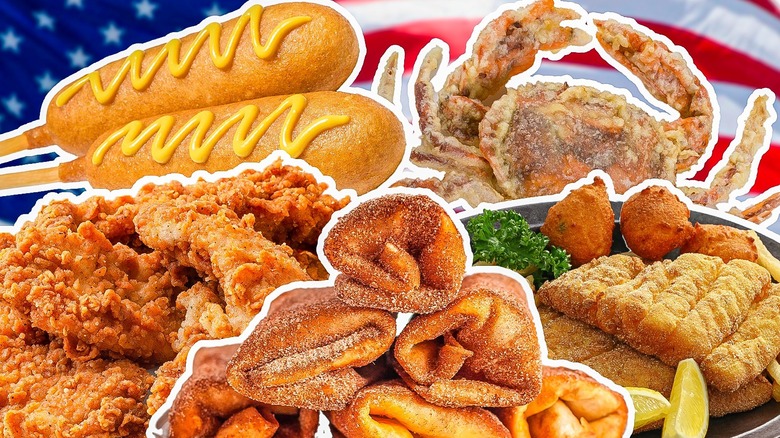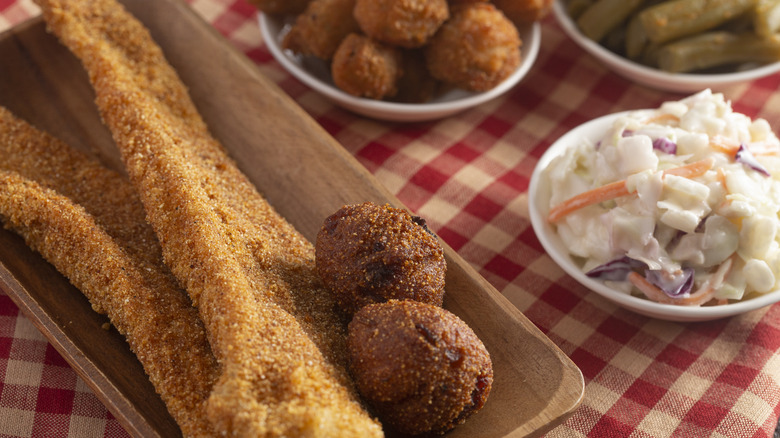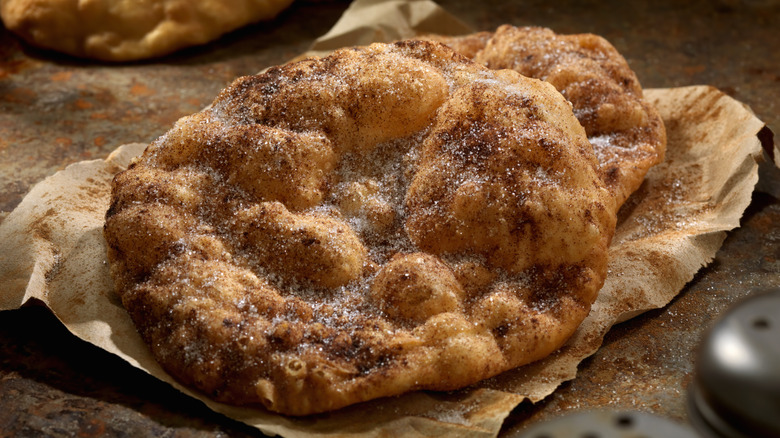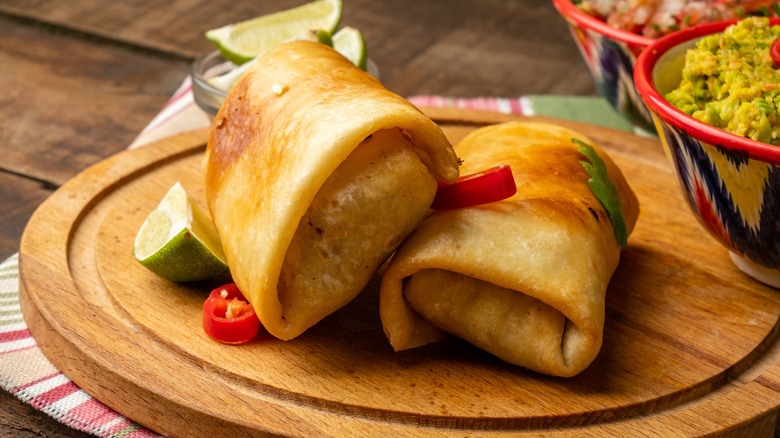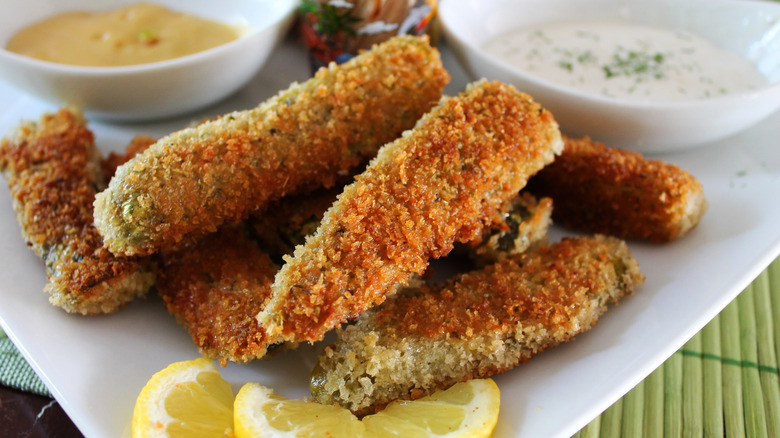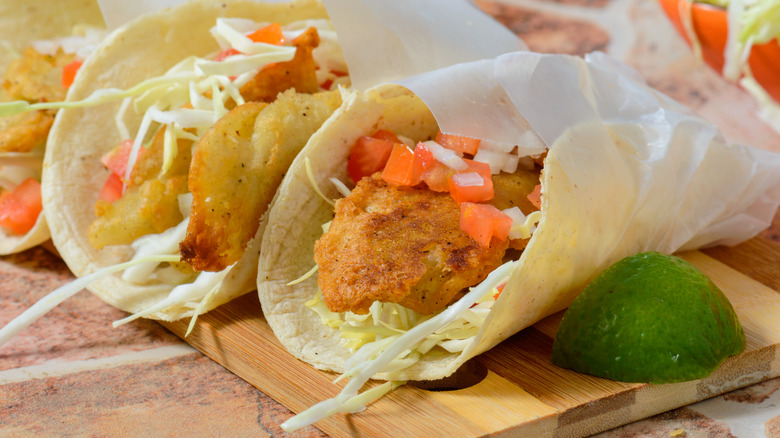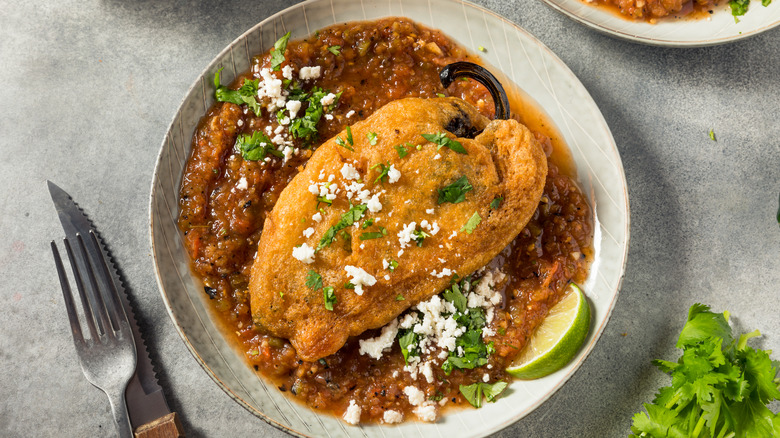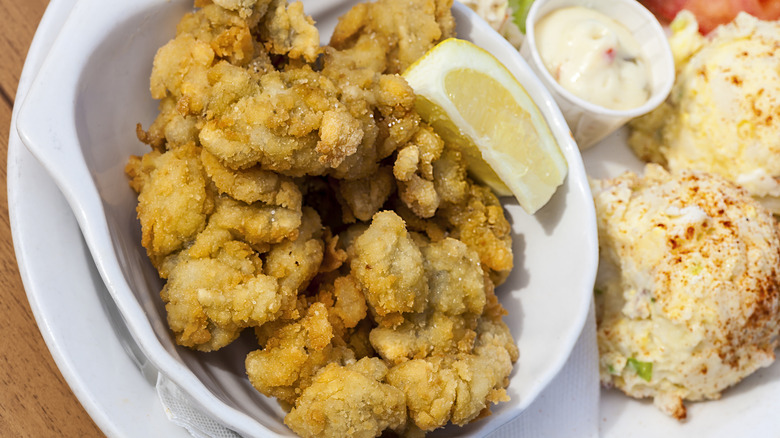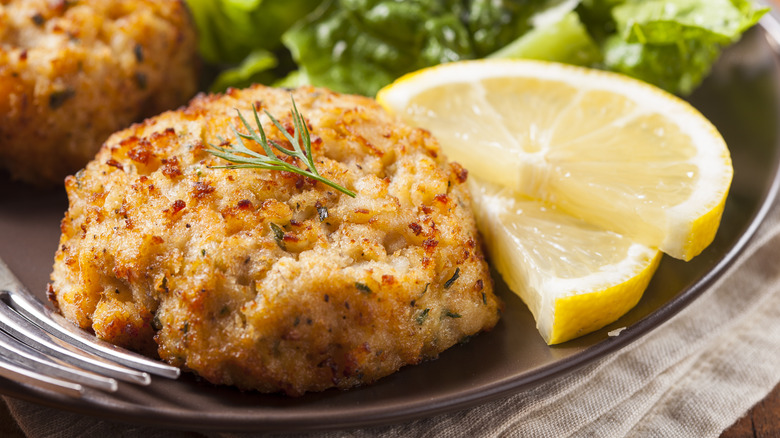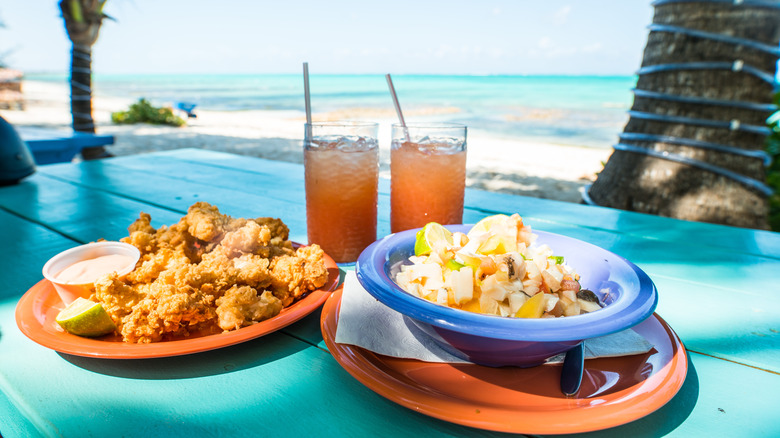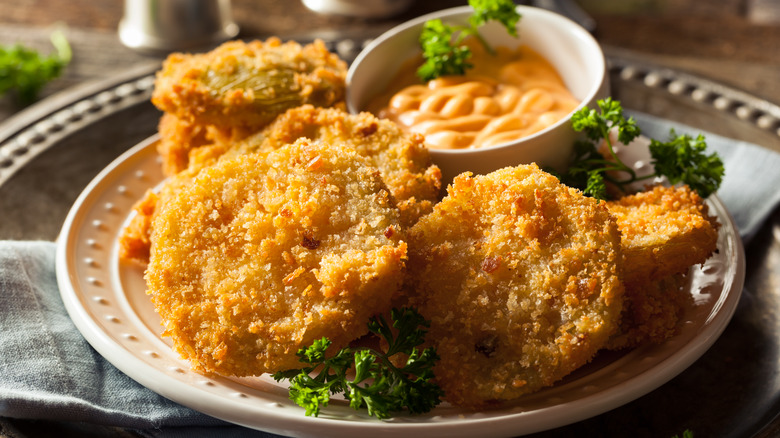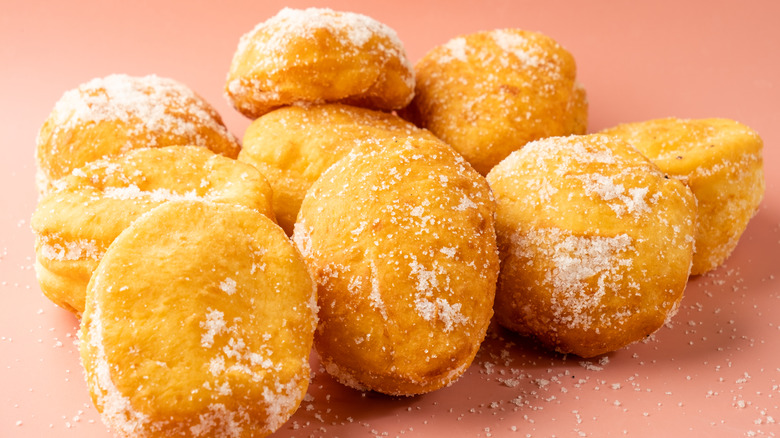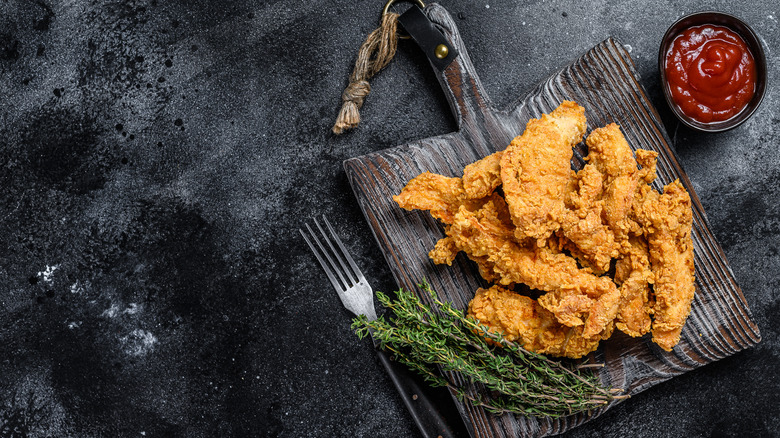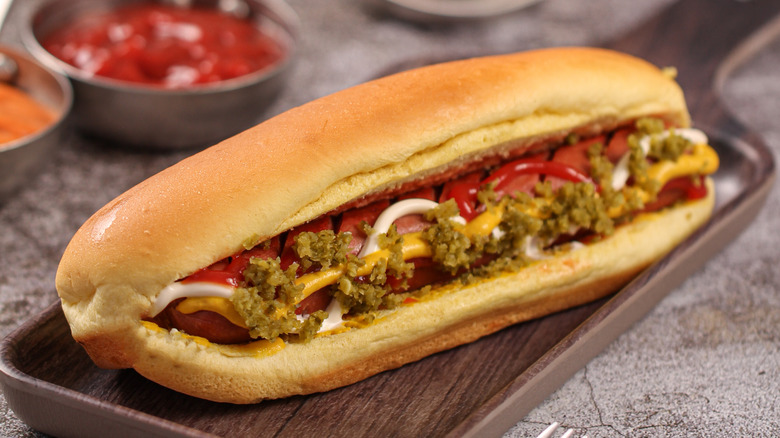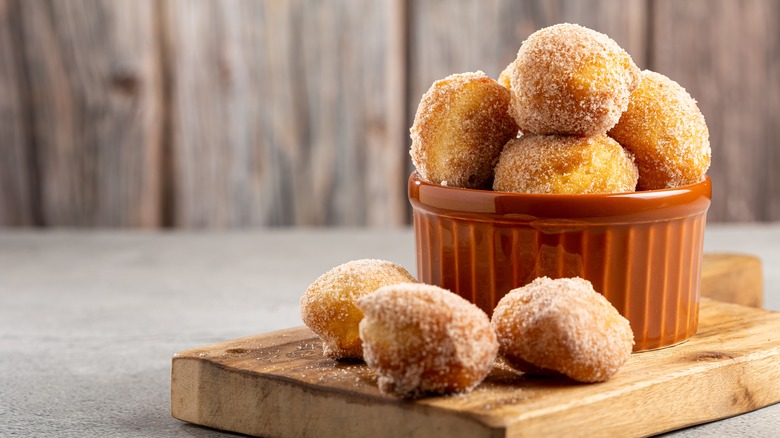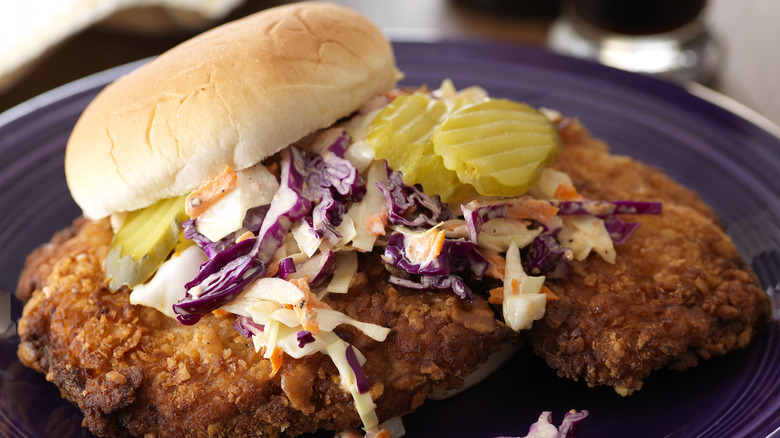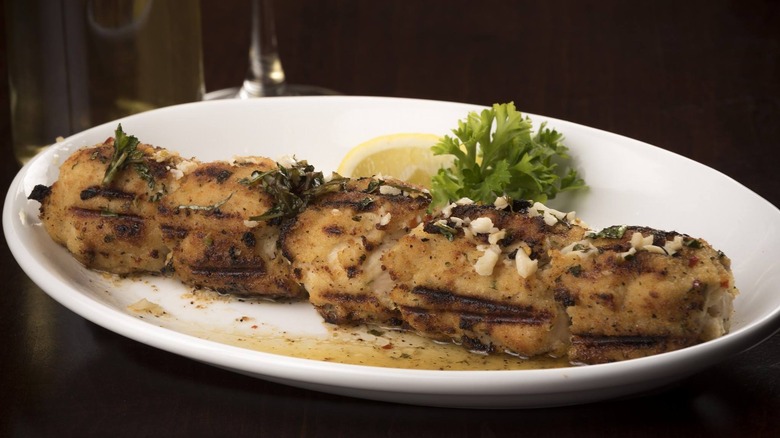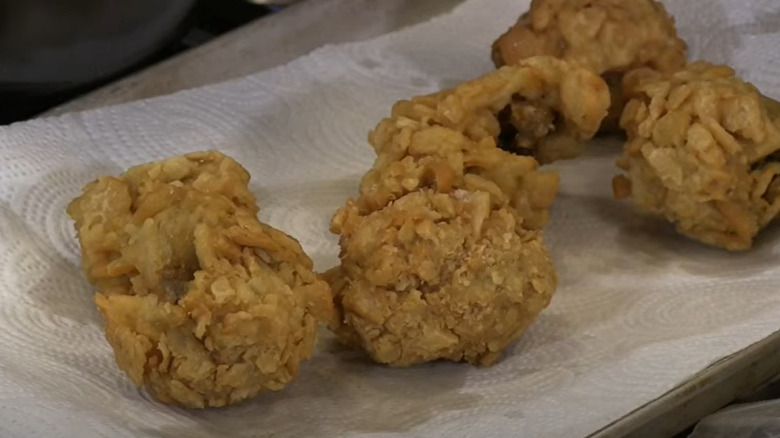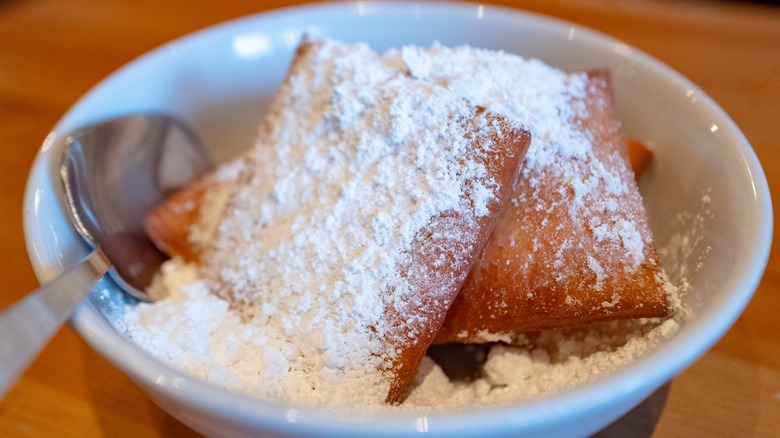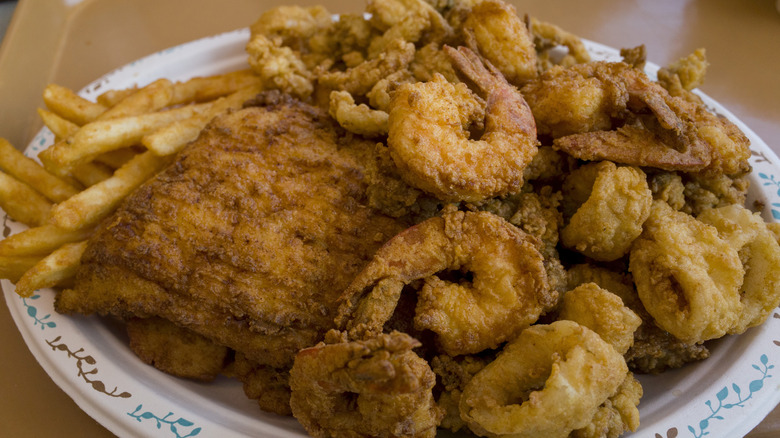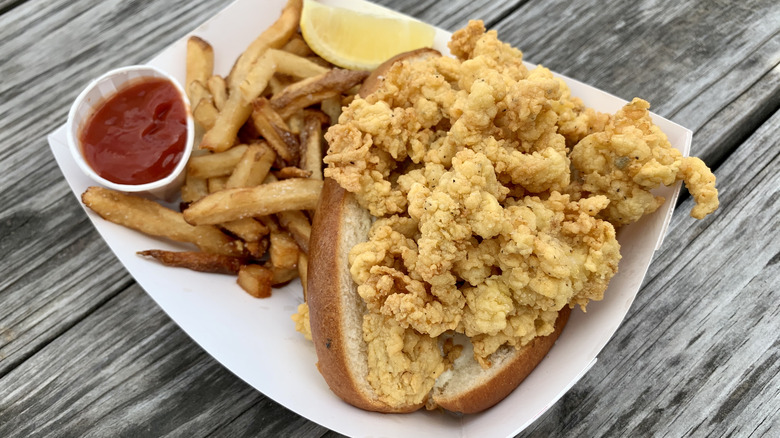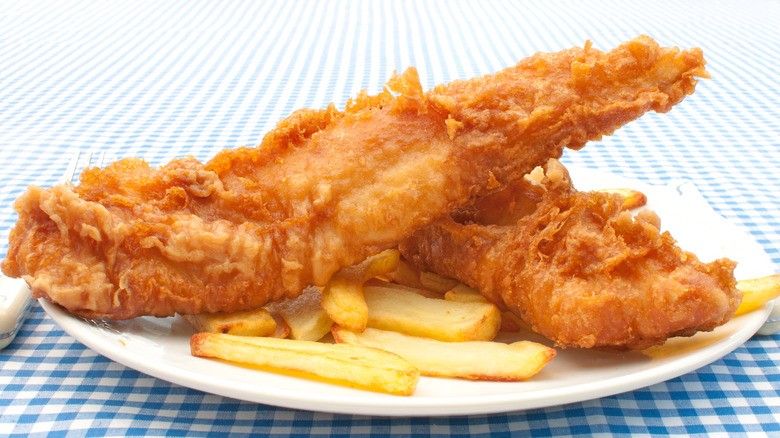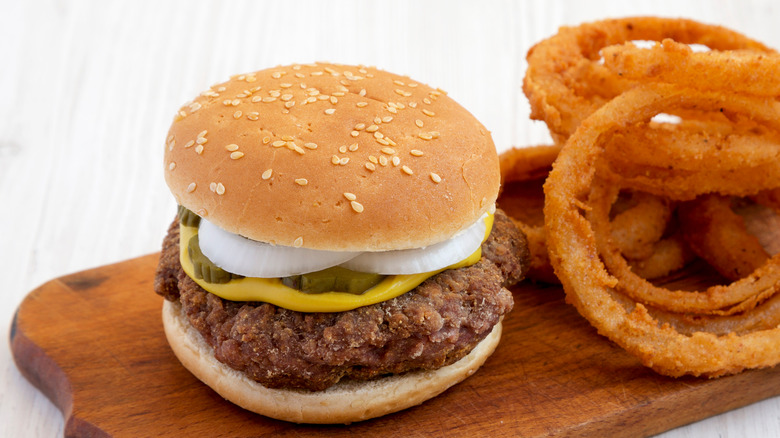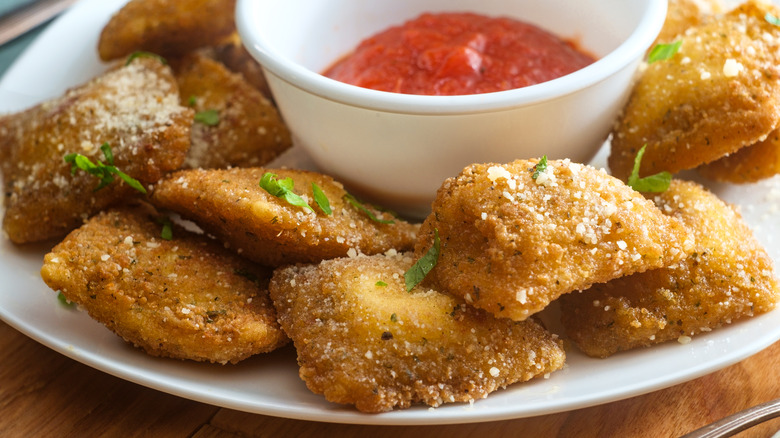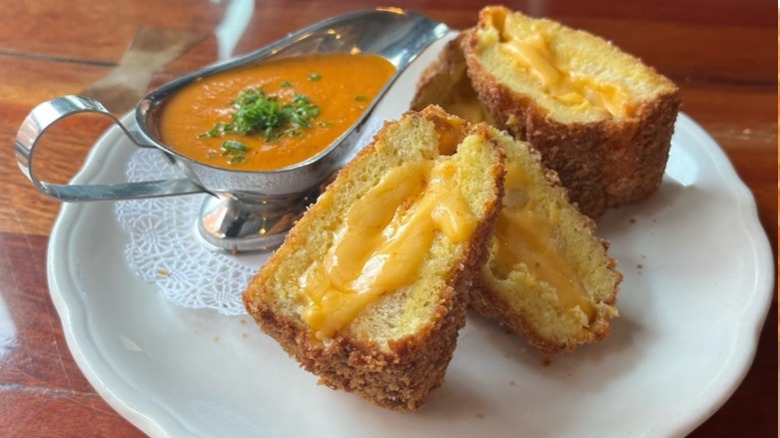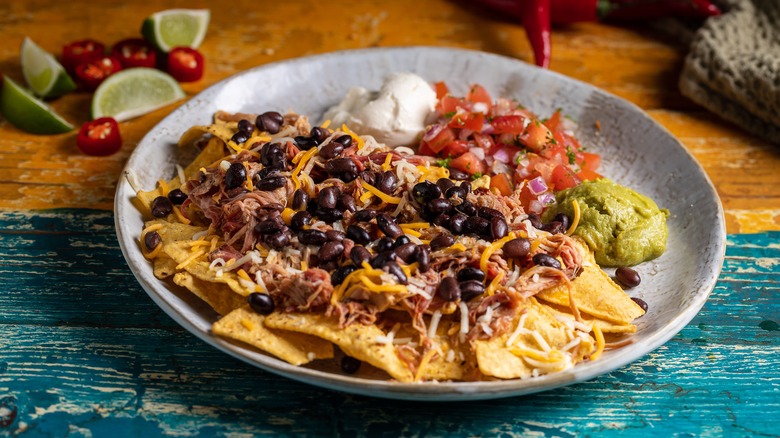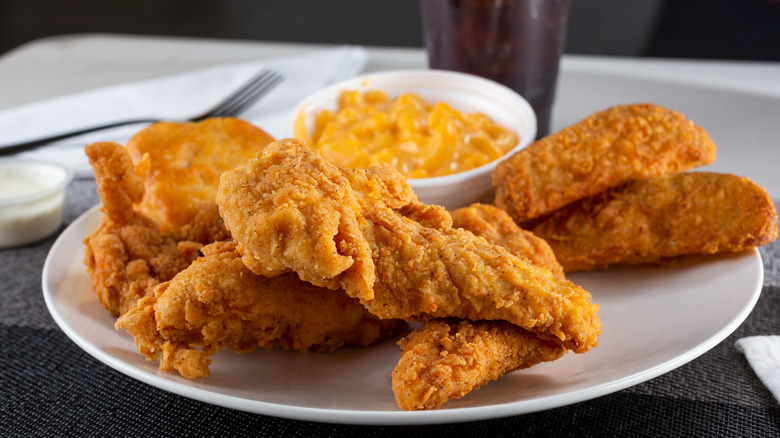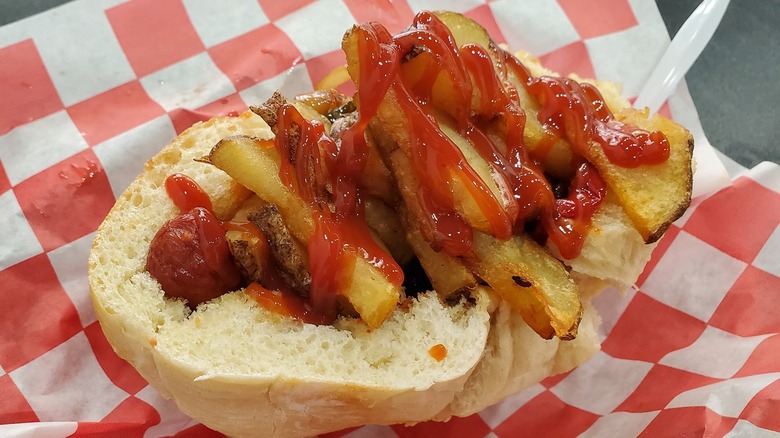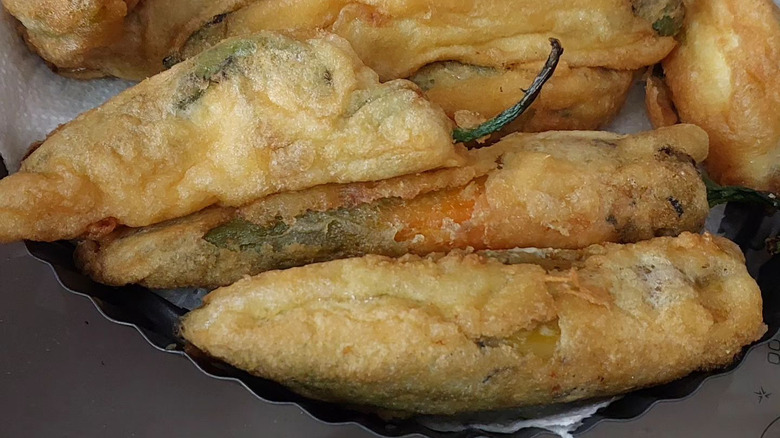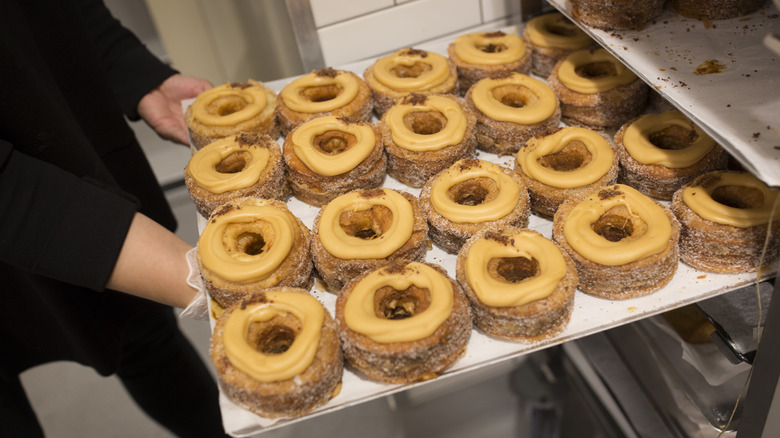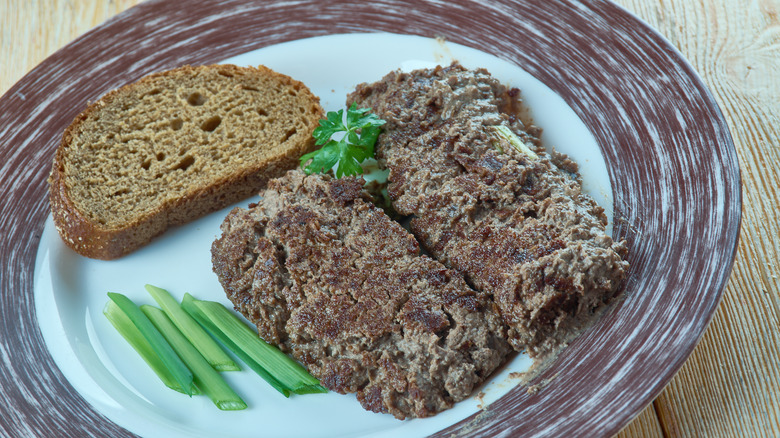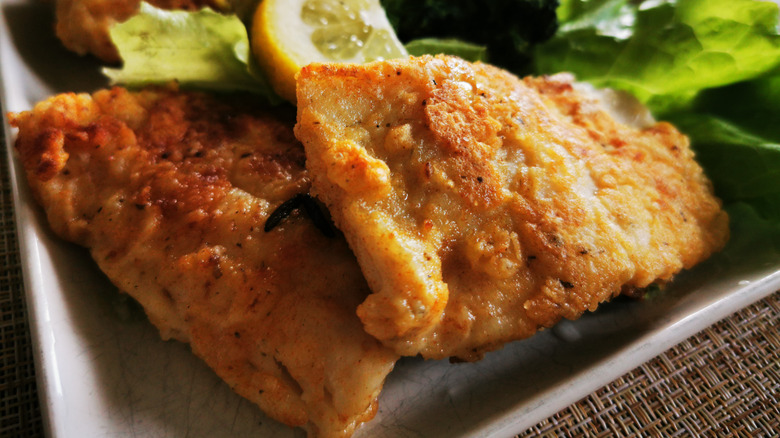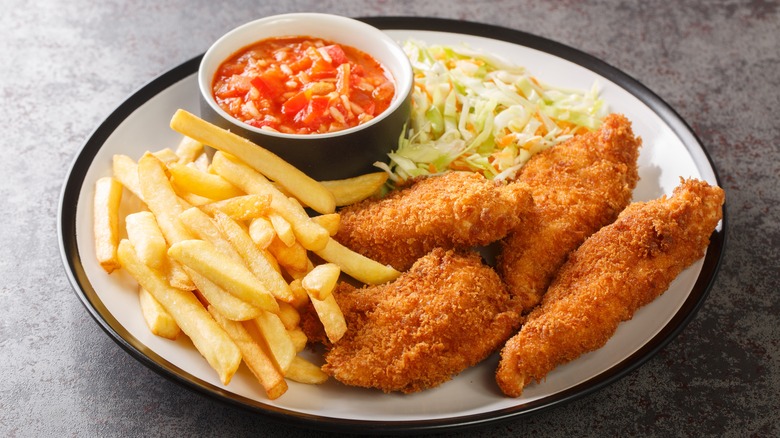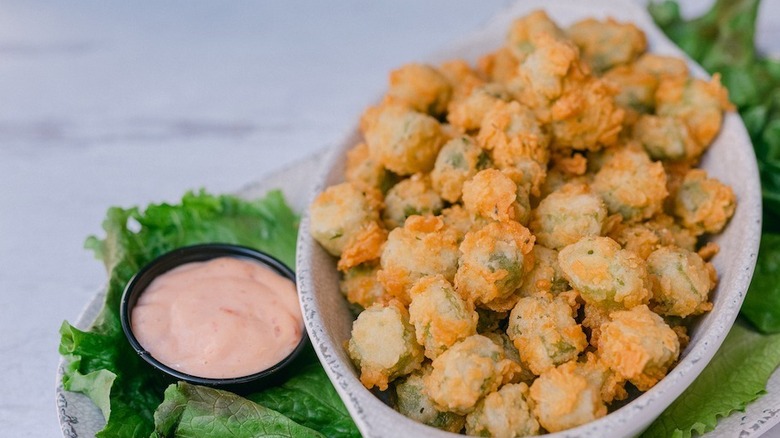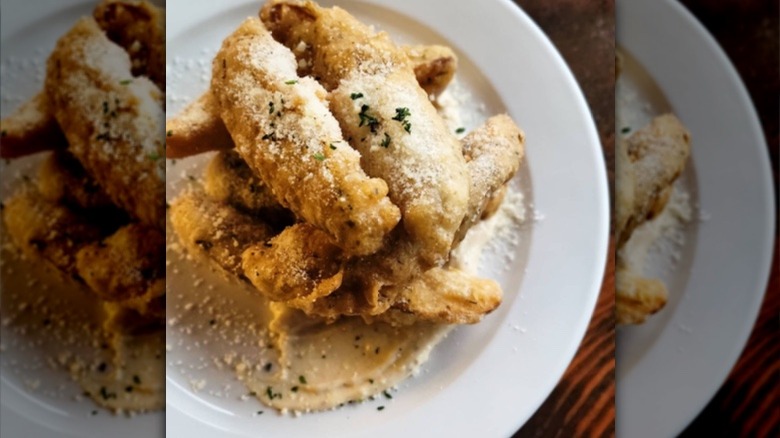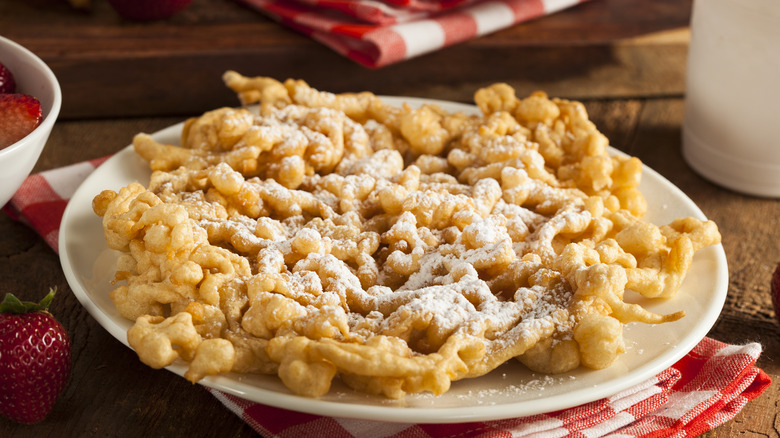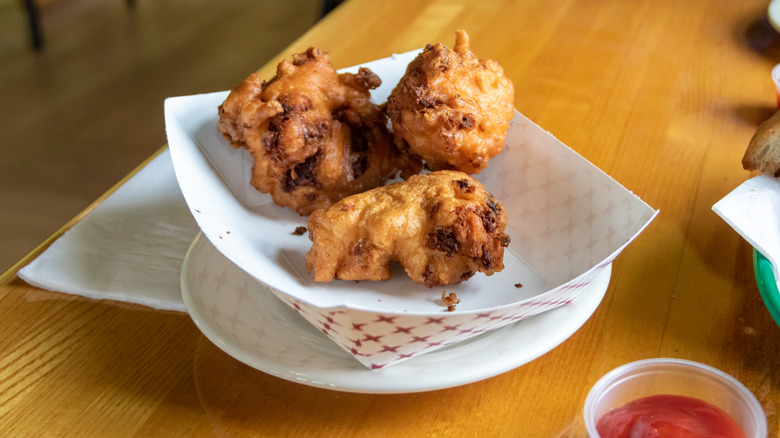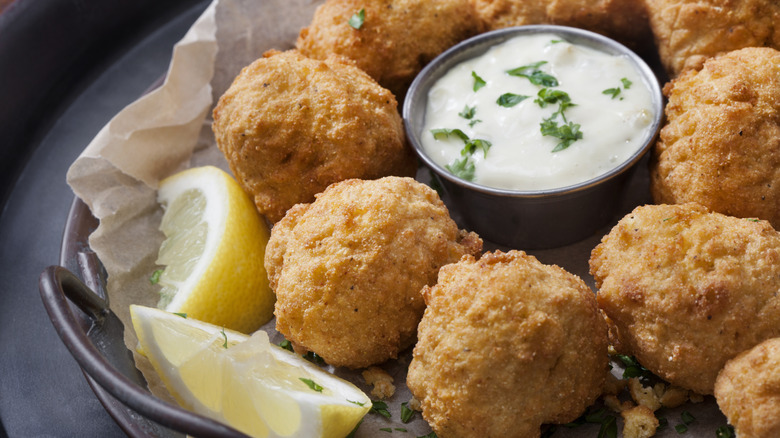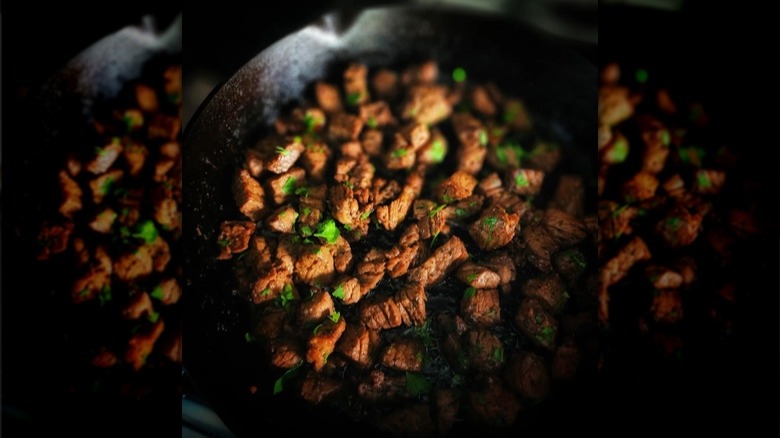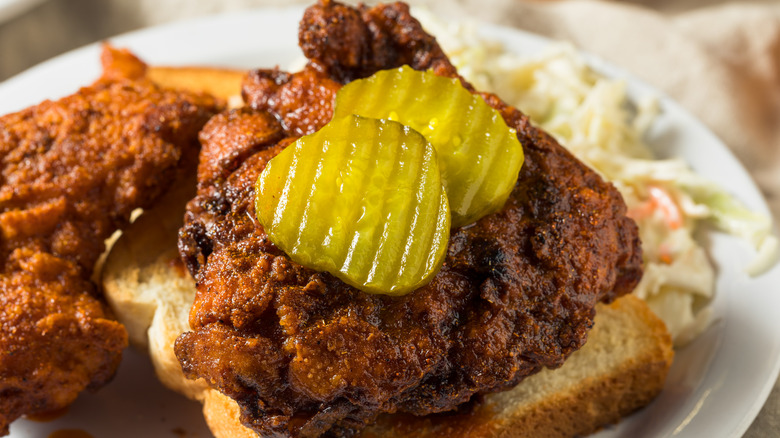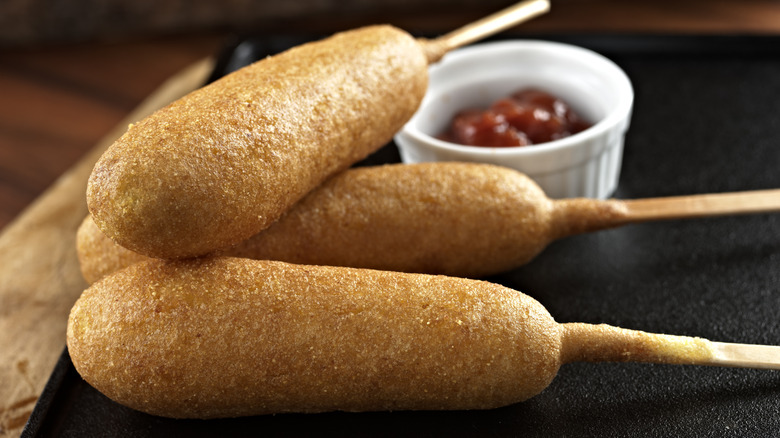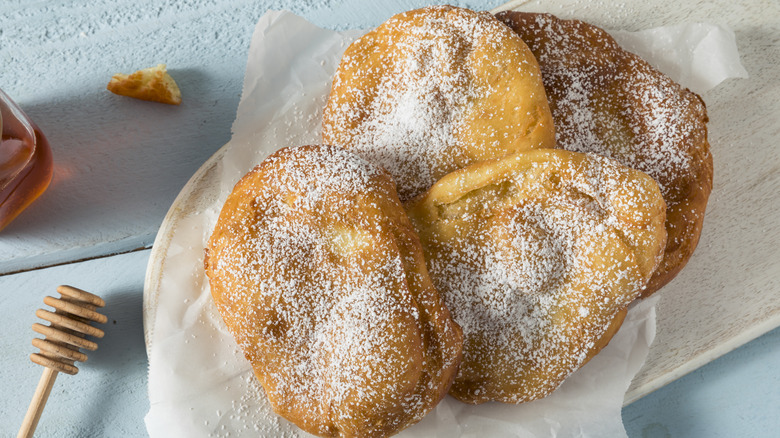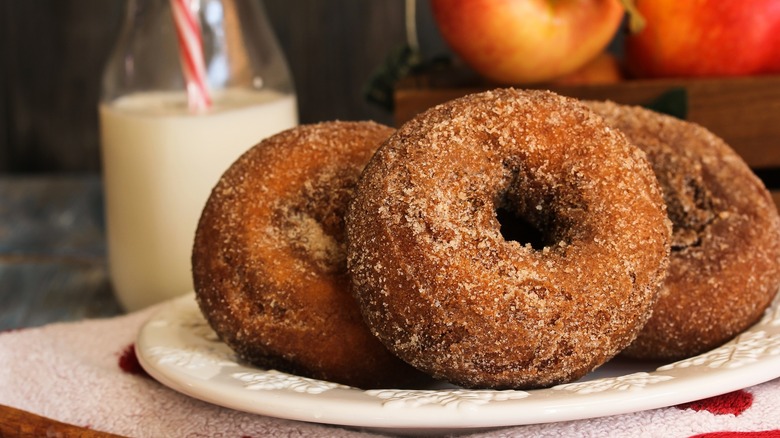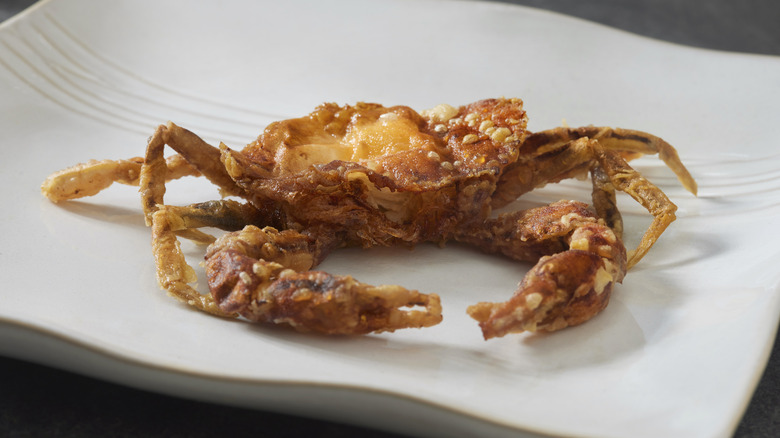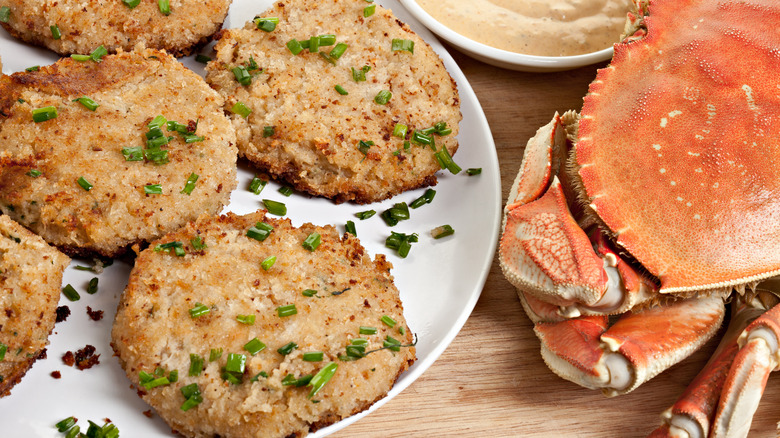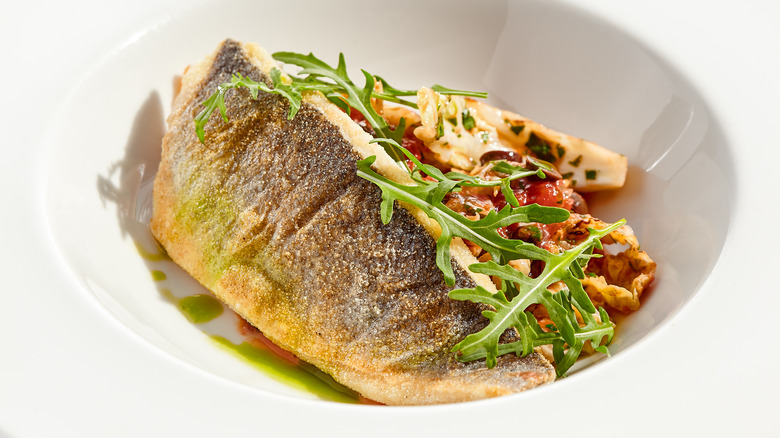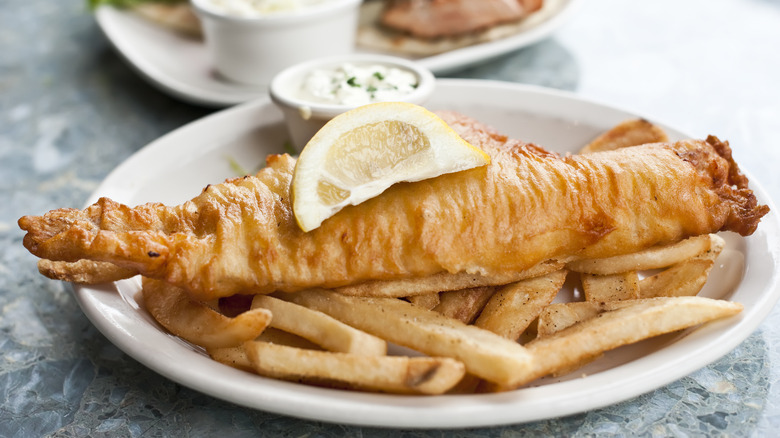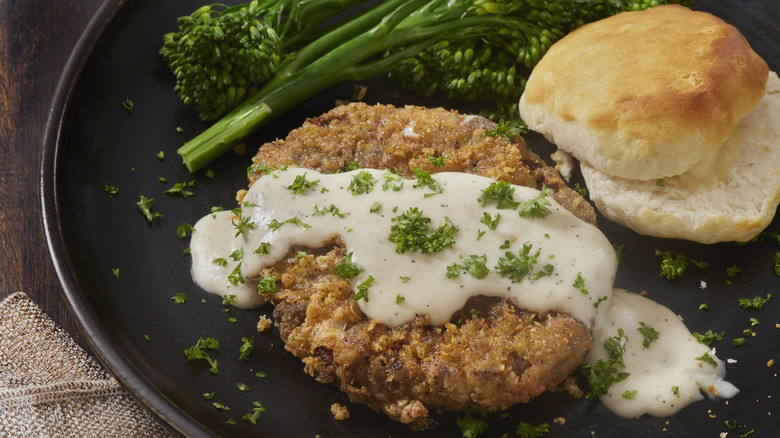The Fried Food You Need To Try In Every State
Fried food has no regional boundaries. Frying is one of those ancient cooking techniques that many nations and cultures have adopted to create some of the most legendary world-famous nibbles. Today, the United States is probably one of the leaders in the frying department. It's certainly a place that gave momentum to the idea that everything will taste better fried.
The U.S. has followed the frying trend and diligently worked to create numerous versions of fried dishes. Some meals have remained regional things that are confined within state borders, but others have become American favorites, with the best even making a name for themselves outside the U.S.
With such a rich frying heritage, it's logical that every American state now has a favorite fried dish. Whether these crispy delicacies were created at a location in the state or adopted or perfected in the area, these are the fried foods you should try in each American state.
Alabama: Fried catfish
Alabama is known for its amazing take on fried chicken and other Southern staples, but fried catfish best captures the true character of traditional Alabama cuisine. The state is packed with restaurants that serve perfectly-executed versions of breaded and fried catfish. The crisp coating should keep the fillets moist and juicy, while spices provide a touch of heat that perfectly complements the catfish flavor. If it's your first time enjoying fried catfish, keep the pairing traditional with crispy hush puppies and creamy coleslaw.
Alaska: Alaskan fry bread
Fry bread is part of many native culinary traditions and is often associated with the Navajo Nation. Created at a reservation where native food was not available, fry bread was an ingenious way to use government rations to feed people.
It is not clear how fry bread appeared in Alaska, but the version is usually made with yeast and sugar. This hefty piece of golden, puffy bread is then often topped with sweet garnishes, such as cinnamon sugar or fruit jams.
Arizona: Chimichanga
If you've never looked into the history of the legendary chimichanga — perhaps best described as a fried burrito — you might be surprised to learn this dish isn't Mexican. It was created on American soil, though it was clearly influenced by Mexican culinary heritage.
Though the exact location is not known, chimichangas first appeared in Arizona. Be aware that a traditional chimichanga is not a light dish. It comes packed with meat — usually beef or chicken — rice, and various add-ons.
Arkansas: Fried pickles
Fried pickles were invented in the Bear State by Bernell Austin, an Atkins local who ran a drive-in just outside a pickle factory. As the story goes, in 1963, he started experimenting with a fried pickle recipe, eventually attaining the perfect version with sliced pickles that were breaded and fried until crispy. The idea was later adopted by other restaurants, making fried pickles a regional specialty that's since gone national.
California: Fried fish tacos
California has many local specialties, but fried fish tacos should not be missed. The origin of fish tacos is probably in Mexico's Baja California, but these scrumptious meals are now a staple in California, especially in coastal areas close to the Mexican border. A standard order consists of deep-fried flaky fish nestled inside a corn tortilla and complimented with garnishes and sauces that provide zest and spice. Fish tacos are simple, unpretentious, and ideal for hot Californian weather.
Colorado: Fried Pueblo chile
The Pueblo chile is a local treasure in that state of Colorado. This unique chile variety was first cultivated at the beginning of the 20th century and became an important feature of the local economy, but its origin is still shrouded in mystery.
There are many ways to enjoy Pueblo chile, but you want to go for the stuffed (relleno) version. Though it also comes in baked form, fried stuffed Pueblo chile is the ultimate delicacy in which the crispy shell is usually loaded with gooey cheese.
Connecticut: Fried clams
As in other parts of New England, seafood should be your go-to meal choice in Connecticut, as the options are fresh and plentiful. For the best fried option, go for bite-size nuggets of deep-fried clams, a regional staple served at restaurants and clam shacks along the coast.
These clams are traditionally fried with the bellies attached, meaning that all the sweetness and juiciness of the meat will remain nestled inside the crispy breaded crust. Go all-out and drizzle some lemon on top, then pair the clams with fries and a heap of tartar sauce.
Delaware: Crab cakes
Many places in the U.S. make fantastic crab cakes, but Delaware might do it best. The recipe for this regional specialty is not set in stone, and many variations pop up at casual and elegant eateries across the state. Crab plates are slightly more elaborate, in which the cakes are served with various side dishes that incorporate potatoes, salads, and veggies. The more laid-back version comes simply nestled inside a bun. Regardless of your preference, you will not have a problem finding a well-executed version of your favorite type of crab cake in Delaware.
Florida: Conch fritters
For the unacquainted, conch is a type of sea snail that's mostly found in the Caribbean, though it is also native to the coastal areas around Florida. The edible part of the snail is nestled inside a sturdy shell. After harvesting, that meat is first tenderized, then combined with various ingredients to make a batter that is shaped into golf-sized balls and fried until crispy. Conch fritters are best served fresh, with a drizzle of lemon and a dipping sauce on the side.
Georgia: Fried green tomatoes
Fried green tomatoes are lauded as a Southern specialty. They became nationally known after the release of the heartwarming '90s movie, "Fried Green Tomatoes," which placed the dish at the center of the story. As it turns out, the movie made the dish into a Southern classic, not vice versa.
Regardless of the dish's exact origins, fried green tomatoes are now a staple in the South. If you're in Georgia, eat at the Whistle Stop Café, the movie location that still serves this fried classic.
Hawaii: Malasadas
In Hawaii, the search for the best fried dish stops with malasadas. These deep-fried doughnuts were influenced by Portuguese immigrants. Other locals readily adopted this sweet tradition and made malasadas a local specialty.
Made with a brioche-like dough, malasadas are plump, round, and lack a donut hole. Though they are traditionally left plain and rolled in sugar, many newer versions employ creative fillings inspired by local and international flavors.
Idaho: Finger steaks
Idaho may grow some of the best American potatoes, but we will pass on the fries this time and go with another fried regional specialty. Finger steaks are thin strips of beef that are first coated in flour and egg wash, then fried until crisp. The shape of these strips is ideal for dipping in sauces and pairs well with more traditional potato-based fries. To remain in line with local tradition, enjoy your finger steak with fry sauce, a local concoction similar to cocktail sauce that combines mayonnaise and ketchup.
Illinois: Francheezie
A francheezie might not be one of the most widely-known items in America but, in Illinois, this hot dog specialty that incorporates cheese has a seriously devoted following. A typical Francheezie consists of a hot dog that has been sliced lengthwise, then is filled with cheese, and then wrapped in bacon. Next, the concoction is deep-fried in sizzling oil before it's touched inside a bun and topped with a variety of condiments.
Indiana: Fried biscuits
You simply do not leave Indiana without trying some fried biscuits. Cooks making this simple concoction use classic biscuit dough that they fry until each piece is golden, crisp, and reminiscent of doughnuts.
Fried biscuits are traditionally paired with apple butter, but they go far beyond dessert. The plain version can be enjoyed as a starter or side with a savory main course, while the ones rolled in a generous amount of cinnamon sugar can make for a scrumptious dessert.
Iowa: Tenderloin sandwich
Iowa is well known for its pork production, so choosing anything other than its take on fried pork tenderloin would be blasphemous. To make it, lean and thinly pounded pork tenderloin is coated in flour, egg, and breadcrumbs or saltine crackers. It's then fried until golden and crisp. You often see it served in a bun, though the combination can seem ludicrous as the generous size of the fried meat means it often overhangs standard-sized buns.
Kansas: Fried chicken spiedini
Spiedini is a deep-fried skewer considered one of the finest Kansas specialties, though its origins lie in southern Italy. Skewered meat was first brought to New York by immigrants from that region. In the U.S., it was usually made with grilled beef. The Kansas-style chicken version originated in 1989 at Garozzo's Ristorante in Columbus Park. The latest version was developed by Anthony and Teresa Spino, who borrowed Garozzo's idea but deep-fried the marinated and breaded skewers in hot oil, creating a signature Kansas dish.
Kentucky: Rolled oysters
To get Kentucky's must-try fried dish, you must first head to the city of Louisville. Rolled oysters are essentially deep-fried oysters that have been coated in a generous amount of breadcrumbs or crushed crackers. They are sometimes fried in clumps, resulting in rather massive fritters.
As the local story goes, rolled oysters were invented by Phillip Mazzoni, who ran a bar and started serving them to his guests. Eventually, the popular dish became a Louisville bar tradition that you can still enjoy in the area.
Louisiana: Beignet
A beignet is a fried square of dough that's covered in copious amounts of powdered sugar. The tradition of making beignets evolved under French and Creole culinary influence in Louisiana in the 18th century, and is now one of the best-known Louisiana specialties.
Beignets are usually enjoyed for breakfast, along with milk-laced coffee, but these treats are suitable for any time of the day. New Orleans' Cafe du Monde is the most famous place to enjoy a classic fried beignet, but you can easily find them at other locations or even attempt to make your own.
Maine: Fried seafood
Maine is well known for its seafood, and though the famous lobster roll is usually heralded as the state's signature specialty, other options include a variety of fried specials that make excellent snacking options. The state is packed with seafood shacks dispersed along the coastline that should be your go-to places for fried seafood. The menus typically include seafood platters which present a great way to sample a variety of seafood. Fried oysters, fish and chips, or fried clams are also worth trying.
Maryland: Fried chicken
It may seem a little too obvious, but fried chicken from Maryland is unique in both preparation and serving style. The first written mention of this dish dates to 1886, but this dish is probably much older than that. There is no universal recipe for Maryland fried chicken, but regional technique dictates that pieces should be fried with the lid on. Finally, crispy Maryland fried chicken cuts will come doused in white gravy, similar to what's served on top of a chicken fried steak.
Massachusetts: Clam roll
The lobster roll may be the more famous sandwich roll from Massachusetts, but if you are craving something fried, this crispy clam version is the obvious choice. Ideally, the roll is made with whole-bellied clams coated in a light breading and tucked inside a tender hot dog roll.
The only addition you need is a generous portion of zesty tartar sauce. As the local lore says, fried clams were invented in Essex. You can still try them at Woodman's, where they were first whipped up in 1916.
Michigan: Pączki
As you can easily guess, pączki are not an authentic Michigan invention but are intricately related to the history of the Great Lakes State. Pączki are round, deep-fried doughnuts of Polish origin brought to the U.S. by immigrants who began arriving in Michigan in the 19th century. These jelly doughnuts were traditionally eaten on Fat Tuesday (known as Mardi Gras in New Orleans). Some bakeries only sell pączki beginning in February and ending on Ash Wednesday. Others sell them as a year-round staple.
Minnesota: Fried fish
Minnesota is well known as one of the best places in the U.S. to catch freshwater fish. Frying is a natural partner here. Fish fry events are especially popular on Fridays and during Lent, but you can find great spots for fried fish throughout the year.
Fish and chips are a standard order, but make sure to try local favorites such as walleye, the official state fish. Crispy fries and a dipping sauce on the side are mandatory accompaniments.
Mississippi: Slugburger
A slugburger probably won't take the top spot on the list of the best American burgers, but as a unique relic of a bygone era, it's still a must-try. Firstly, let's make one thing clear: there are no slugs in the burger. The patty is actually a combination of ground meat and a potato flour filler.
The slugburger was first developed during the Great Depression, a time of hardship where people sometimes had to get creative just to eat. Despite its name, a well-crafted slugburger is a delicious and unpretentious meal that deserves genuine love.
Missouri: Toasted ravioli
Despite the name, toasted ravioli is breaded and tossed into a copious amount of oil until the thin, tender pasta turns into a golden-colored, crunchy treat beloved by many Missourians. These crispy nuggets are a St. Louis specialty but are no longer limited to their native city or even just the state. You can find them packed with a variety of typically savory fillings, and they usually come garnished with grated cheese.
Montana: Rocky Mountain oysters
Rocky Mountain oysters are served in many western states, including Montana. Don't be deceived by the name, however, as this dish has nothing to do with briny sea oysters or any type of seafood in this landlocked state.
Instead, Rocky Mountain oysters are made with bull testicles that have been cleaned, dredged in flour, and deep-fried until crisp. The testicles can be sliced or left whole and, like many a fried dish, come with dipping sauce on the side.
Nebraska: Cheese frenchee
The cheese frenchee is an ingenious Nebraska specialty with no counterpart elsewhere in the U.S. A classic cheese frenchee is a deep-fried cheese sandwich. Yes, it might sound a tad over the top, but it is also crazy delicious. We don't see anything wrong in taking a carb-loaded cheese sandwich, breading it, and then deep frying it to attain a crisp golden crust that protects the gooey, cheese-filled center.
Nevada: Fried nachos
Nachos may not have much in common with Nevada regarding its history or origin. However, nachos made with fried tortilla chips should be the fried dish of choice here. That's because the state, with the flamboyant gambling town of Las Vegas, perfectly matches fried nachos' excessive, lavish character.
Whether you are a fan of the classic version or go for the new, quirky combo, Las Vegas abounds in nacho options. Nacho Daddy is one of the most reliable locations that always delivers on this dish.
New Hampshire: Chicken tenders
Chicken tenders might not be the craziest fried food, but there is a reason why they're an all-time favorite across all age groups. Breaded and fried strips of chicken breasts that simply beg to be dipped in a sauce are common to most U.S. regions, but New Hampshire might be where they originated. That's according to the proprietors of the Puritan restaurant, where the dish was allegedly first whipped up in 1974. That's where it's still served and loved by the patrons of this Manchester spot.
New Jersey: Italian hot dog
The Italian hot dog has its origins in Newark, where a hot dog is deep-fried in sizzling oil until it cooks through and crisps up. It's served inside Italian-style bread with classic garnishes like mustard, ketchup, onions, and peppers. But the fun does not stop there. To top it all, fried potatoes are piled on top. This monumental creation has been a local favorite since it was invented in 1932.
New Mexico: Chiles rellenos
Chiles rellenos in New Mexico are usually made with Hatch chiles, a green pepper variety that is first grilled, then skinned and stuffed with cheese. In New Mexico, stuffed chili peppers can be baked, but fried ones are filled in a thick egg batter, similar to the one used for pancakes, before being cooked in oil. As it sizzles, the batter will make a nice crispy coating around the peppers, and the heat will melt the cheese filling.
New York: Cronut
Despite its fairly recent origin in 2013, the cronut is already lauded as a legendary deep-fried treat in NYC. Invented by Dominique Ansel, this quirky pastry is a fusion of a croissant and doughnut with a doughnut-like shape, but with distinctive croissant-like flakiness. Each cronut is rolled in sugar, filled with cream, and glazed. The flavors continually change, but the true magic of the cronut is in the sugar-coated crispy shell and the buttery, layered center.
North Carolina: Livermush
Livermush is one of those vintage foods that should be preserved despite newer and perhaps more attractive food trends. As the name suggests, this is a dish made with liver, or more precisely, a mix of liver, meat, cornmeal, and spices. It's cooked and blended into a mush that is then nestled into rectangular molds. One firm, the pieces are sliced and pan-fried until they attain a thin crust. Though it is not as common as it used to be, livermush is a North Carolina specialty that remains a must-try.
North Dakota: Fried walleye
Walleye is a popular catch in several Midwest states, including rivers and lakes in North Dakota. Naturally, you will often see it on menus there. Though there are many ways to cook it, frying is possibly the best option for this flaky fish, as it has few bones and carries a mild, almost neutral flavor. As a walleye filet tends to pack in a lot of meat, it generally remains juicy throughout cooking.
Ohio: Barberton-style chicken
Barberton-style fried chicken comes from the Ohio city of the same name. The dish is made with a whole, brined chicken, pieces of which are dipped in egg wash, drenched in flour, and then fried in lard. This recipe was developed by Serbian immigrants during the Great Depression. Smiljka and Manojlo Topalsky were the first to make and sell this fried chicken version but were soon followed by other Serbian families in the area.
Oklahoma: Fried okra
Despite its grim past as a food brought to the Americas by enslaved West African people, okra is now intricately connected to the American South and represents one of its most important culinary legacies. Though it is a common food in other states, Oklahoma has promoted okra as one of its regional food specialties. This unique veggie can be used in various ways, but its true character best shows up when it's been rolled in cornmeal and fried until crispy. Fried okra makes a great appetizer or side dish and is best paired with a dipping sauce.
Oregon: Jojo potatoes
Jojo potatoes have nothing in common with your regular French fries. This Oregon specialty is made with seasoned potato wedges that are breaded and deep-fried in pressure fryers. There are many conflicting stories about the origin and name of this dish, but at this point, they all seem irrelevant. Jojo potatoes are a signature Oregon dish that should be eaten, not overanalyzed. They typically accompany fried chicken at stalls, food carts, and restaurants in the state.
Pennsylvania: Funnel cake
Funnel cake is a decadent deep-fried dessert that was made popular by the German-descended ethnic group known as the Pennsylvania Dutch. This deep-fried cake is made with a thin batter that is pushed through a funnel — hence the name — directly into sizzling oil, resulting in intertwined threads of fried dough.
Along with other fried specialties, you will mostly find funnel cakes at fairs and amusement parks. Traditionally, this incredibly crispy treat comes dusted with powdered sugar, though less-traditional toppings have become popular.
Rhode Island: Clam cake
Clam cakes are not exclusive to Rhode Island, but they are mostly associated with the Ocean State and allegedly originated at Aunt Carrie's in Narragansett. They are usually made with sliced clams, eggs, milk, flour, clam juice, and seasonings. The batter is dripped directly into the frier, creating golden and crispy clam nuggets. You can make clam cakes into a round-year treat, but they are best enjoyed during the summer as a quick and filling snack following a trip to the beach.
South Carolina: Hush puppies
South Carolina might be known for many deep-fried delicacies, but the humble hush puppy is arguably one of its most emblematic dishes. Hush puppies are small cornmeal fritters, with other ingredients allowing for plenty of regional and individual variation. Though the origin of the hush puppy and its unusual name remains murky, some suggest that they evolved from similar corn nuggets traditionally made in South Carolina.
South Dakota: Chislic
There was no doubt which fried dish would be crowned the winner in South Dakota. Chislic is such a beloved local staple that it was officially named the state's signature snack in 2018. Traditional chislic consists of big chunks of cubed meat fried in oil. Purists argue that only lamb or mutton can be on the chislic skewer, though beef tips are often used instead. As for sides and dressings, chislic calls for nothing more than a handful of saltines and a dash of seasoned salt.
Tennessee: Hot chicken
No other dish better represents Tennessee than the state's legendary hot chicken. This spicy fried chicken style hails from Nashville. Though numerous places specialize in making it, most purists agree that the must-try version comes from Prince's, a family-owned joint that has been open since the 1930s. What separates this from other fried chicken styles is the level of heat. This dish stays true to its name, as even the mild version reportedly packs a lot of heat.
Texas: Corn dog
Texas is not the only place where you can get a well-made corn dog, but it is where this fun treat might have originated. This is also arguably the state that did most for the treat's image. A corn dog is made with a skewered wiener dipped in cornmeal batter and then fried until golden. They are now one of the staple items found at fairs, amusement parks, and boardwalk stalls. Apart from the classic version, many shops in the Lone Star State and beyond now offer their creative take on this classic.
Utah: Utah scones
Beyond the name, the Utah scone has almost nothing to do its the more famous British version. Best described as a flat deep-fried doughnut, the yeast-based Utah scone is a closer cousin to fry bread and pillowy elephant ears. The origin of the Utah scone is unclear, but some say Mormon missionaries introduced it after copying dishes from Navajo communities. Order it today, and you'll find that the Utah scone is a sweet treat that is usually served with cinnamon-flavored honey butter.
Vermont: Cider doughnuts
One of the best ways to use traditional American cider in cooking is to pair it with deep-fried doughnuts from Vermont. These doughnuts are especially popular during apple harvest and are often made and sold at orchards. There is no set recipe for cider doughnuts, but you can expect a soft treat with a lot of cinnamon flavor. These doughnuts are often simply rolled in cinnamon sugar, but you will also find many cream-filled and glazed versions.
Virginia: Soft shell fried crab
Virginia is among the best places for soft shell crabs in the U.S. The best time to enjoy the fried version is during the soft crab season, which starts in spring and usually ends sometime in September. During this time, the crabs grow a new, softer shell and can be fried whole, resulting in possibly the best fried seafood you will ever have. These crispy nuggets can be eaten as an appetizer or the main course and are often tucked inside sandwiches and bread rolls.
Washington: Dungeness crab cake
Dungeness crab is king in the Pacific Northwest. Hailed for its tender and sweet meat, it is considered a regional delicacy that the locals like to boil, steam, or roast whole. The juicy flesh is also used to make crispy fried crab cakes. These patties have a thin, crispy crust that partners perfectly with the buttery meat inside. They can be enjoyed as a filling appetizer or a light main course, preferably served with a salad and dipping sauce.
West Virginia: Pan-fried rainbow trout
Streams in West Virginia are ideal for catching rainbow trout. As this tender freshwater delicacy is at its best when dipped in flour and pan-fried, it is a natural choice for an excellent fried dish. Local restaurants usually have trout fillets on the menu, which are lightly seasoned and briefly fried, allowing the fresh, flaky trout meat to be the star. They're often paired with buttered potatoes and green beans for a classic experience.
Wisconsin: Fish fry
The Wisconsin fish fry tradition started due to Christian churchgoers who wanted to refrain from eating meat on Fridays. The fact that the state is abundant with freshwater fish settled the idea and made fish fry Fridays a regional thing. As far as the type of fish is concerned, you will mostly find regional favorites in the mix, such as walleye and perch. These are typically dipped in a beer batter and then fried until crisp. Tartar sauce, malt vinegar, and lemon are the standard accompaniments.
Wyoming: Chicken fried steak
Chicken fried steak is not a native Wyoming dish, but the place took this classic in and made it into one of Wyoming's signature fried items. It's only logical that the delicious combination of thinly pounded fried steak would find its home in a state known for its beef production. Chicken fried steak is often served with a generous helping of thick, creamy gravy.
